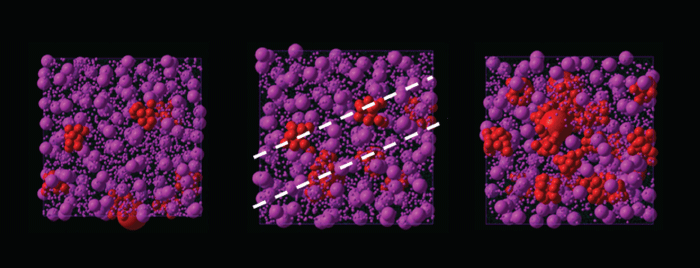A research team led by Joao Maia of Case Western Reserve University created simulations of colloidal suspensions depicting particles contributing to hydroclusters (shown in red), which play a crucial role in the substance’s shear thickening behavior.
Colloidal suspension is the term for a substance that is microscopically dispersed throughout another substance and is found in many every day products – food, cosmetics, drugs. An intermediate between a true solution and a suspension, particles in a colloidal suspension are small, cannot be seen by the naked eye and can easily pass through filter paper, yet they also are large enough to be blocked by parchment paper or animal membrane.
Colloidal suspensions exhibit a transition from a thinning behavior to a thickening behavior as the rate of shearing forces increase. Despite all the experimental and computational studies, an understanding of the structure of suspensions in different flow regimes remains controversial.
A research team lead by João Maia, Ph.D., employed a dissipative particle dynamics (DPD) model on Ohio Supercomputer Center systems to conduct a comprehensive study of the flow and structure behaviors of monodisperse (having particles of similar size) and bimodal (having particles of two sizes) suspensions over a wide range of shear rates.
“Computational studies in general have successfully predicted the local dynamics of colloidal particles, but have been restricted to small-scale systems and failed in explaining large time and/or length scales,” said Maia, director of the Center for Advanced Polymer Processing at Case Western Reserve University. “Similarly, most numerical studies on suspensions have focused on either near-equilibrium flow conditions or on diluted suspensions, because of the difficulties in dealing with multi-body hydrodynamic interactions and their crucial role in such systems.”
Since the original DPD model at times does not account for the lubrication forces that define the fluid behavior, especially in high-shear rates, the team developed a modified DPD model that defined the suspended particles as a hard core covered by a soft shell, which more adequately accounted for the lubrication factors.
“The interplay between flow and structure indicates that hydroclusters are formed in the shear-thickening regime, whereas interparticle interaction is responsible for the shear-thinning response at low stresses,” said Maia. “The effect of particle size, ratio and combination in bimodal systems have also been investigated and quantitative agreement with existing experimental data was found.”
As a result, it was possible for Maia’s group to perform, for the first time, a comprehensive study on different aspects of the bimodal dispersions and correlate the macroscopic behavior with the microstructure in different flow regimes.
Project Lead: João Maia, Case Western Reserve University
Research Title: Bridging the gap between microstructure and macroscopic behavior of monodisperse and bimodal colloidal suspensions
Funding Source: National Science Foundation

